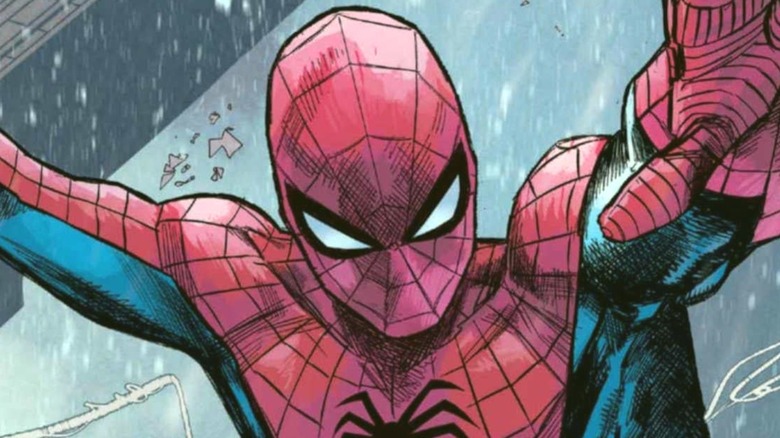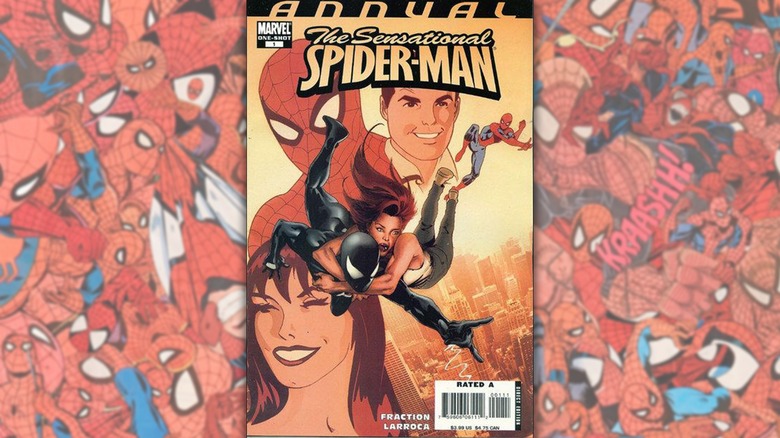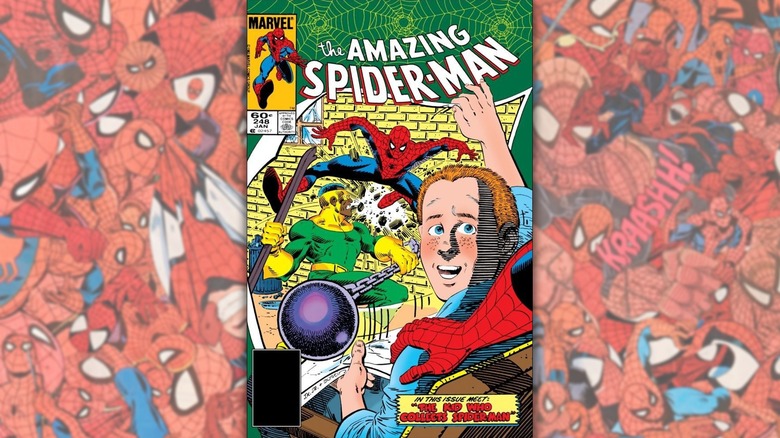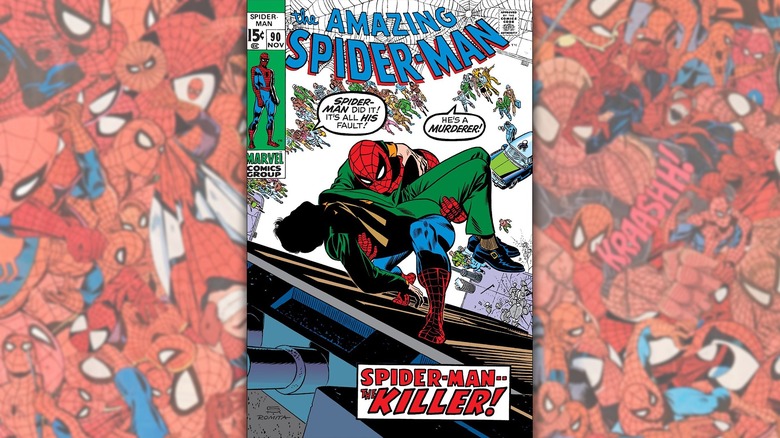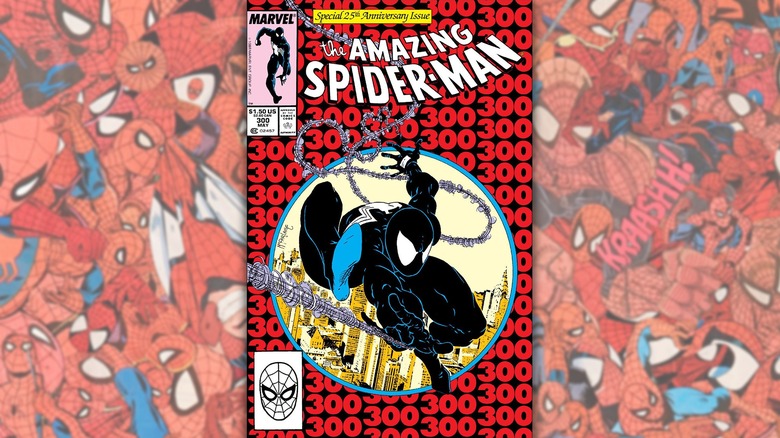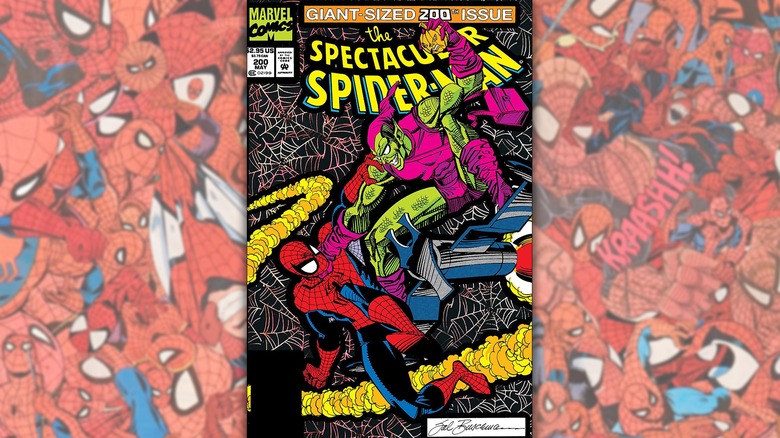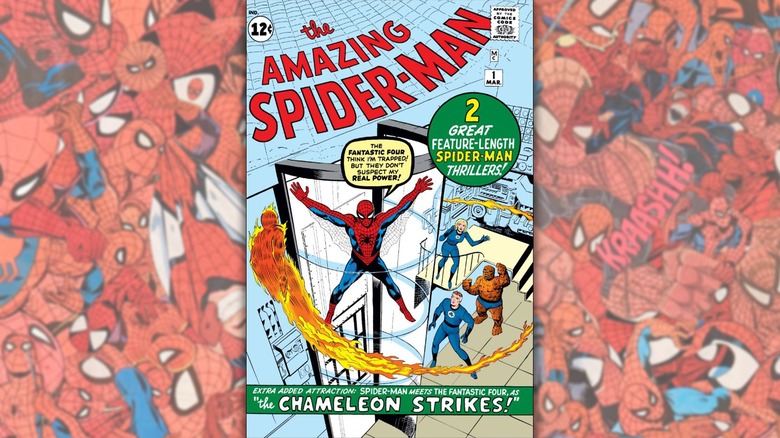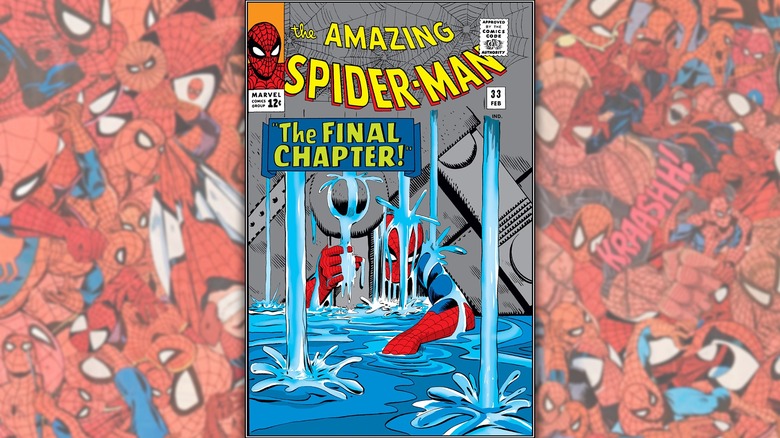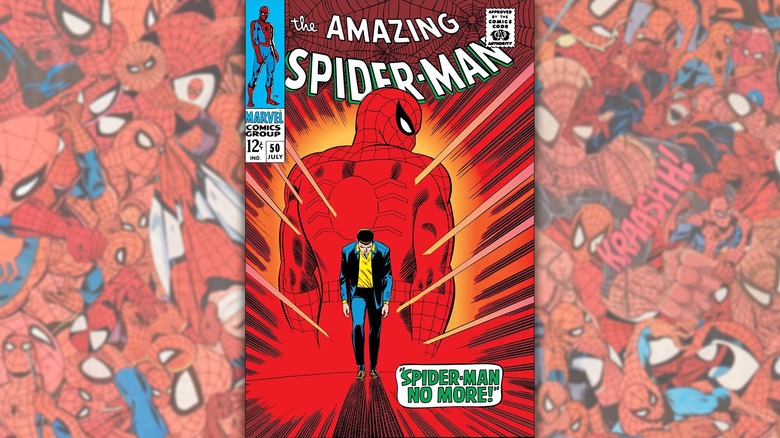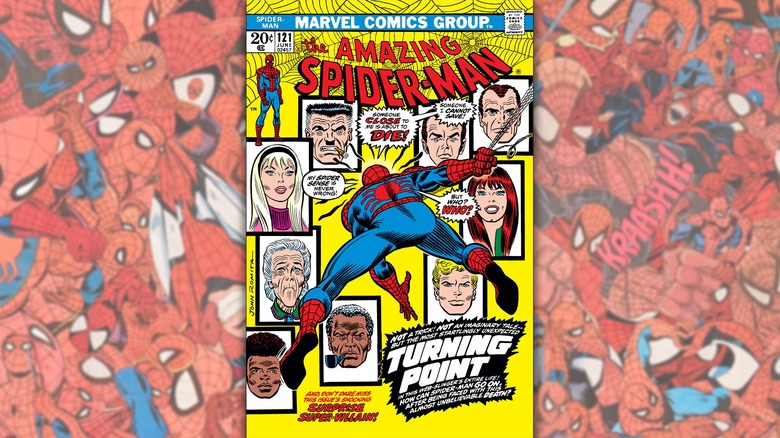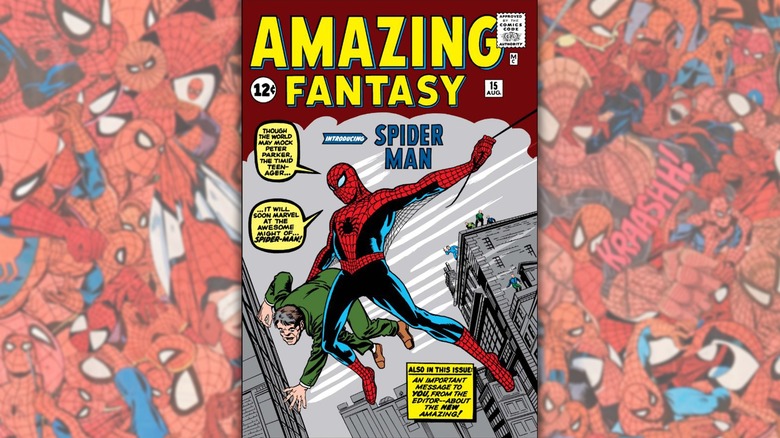10 Best Spider-Man Comics Of All Time, Ranked
Since he first appeared in 1962's "Amazing Fantasy" #15, Spider-Man has been one of the world's most popular comic book characters. Spidey became such a success that Marvel Comics effectively made him its mascot, and he's appeared in more stories than any other superhero the publisher has printed. There have been many different versions of Spider-Man, but the main one has always been Peter Parker from Earth-616 — the primary Marvel continuity — and he's the focus of this article.
Spider-Man has some relatively unique superpowers, or did when he was first introduced, and people have enjoyed delving into Peter's life and adventures for more than 60 years. With thousands of issues to choose from, it's almost impossible to select which are the best Spider-Man comics of all time. But while opinions vary across the fandom, there are some key issues from Spider-Man's publishing history that stand out among the rest.
These are the issues that became incredibly important in Spidey's story, detailing the people he'd meet and the ones he'd lose along the way; these are the tales that made a difference. As such, it's not an insurmountable task to rank the 10 best comics to feature ole' web head. These 10 books represent some of the best Spider-Man stories, the most crucial moments in his life and publishing history, and how well the books sold when they were printed, with their eventual collectability factored in. These are the 10 best Spider-Man comics of all time.
10. The Sensational Spider-Man Vol. 2 Annual #1
"The Sensational Spider-Man" Vol. 2 Annual #1" is the definitive Peter Parker and Mary Jane Watson relationship book. MJ made quite the splash when she was first introduced in 1965's "The Amazing Spider-Man" #25 with the words, "Face it, Tiger ... You just hit the jackpot!" She didn't become Peter's girlfriend for some time, but they ultimately ended up together. Some shenanigans eventually changed all of that, but before Marvel chucked their relationship in the bin, the couple shared a lovely story.
In the book's sole tale, "To Have and to Hold" (by Matt Fraction and Salvador Larroca), MJ is interrogated by SHIELD, which is on the hunt for Peter after he unmasked himself during the "Civil War" storyline. As a stalling tactic, MJ recounts some of the greatest moments she shared with Peter, and elsewhere, Peter does the same thing, thinking of MJ and their time together. Their stories unfold the true nature of their relationship and how much they love one another.
Both characters suffer untold tragedy but keep one another grounded with their compassion, makig this a truly heartfelt story. The book is important in detailing Peter and MJ's bond, especially after Spidey's world is upended in the wake of "Civil War." As a collectible, the issue isn't worth much more than the paper it's printed on, but that's not why it's here. "To Have and to Hold" is an essential Peter and MJ story and one of the best-written Spidey tales of the 21st century.
9. The Amazing Spider-Man Vol. 1 #248
In his own books, Spider-Man often has story arcs that stretch for half a dozen issues or more. Something far rarer is the one-shot storyline that not only kills it creatively but also stands the test of time as a critical Spidey story. Roger Stern and Ron Frenz's "The Kid Who Collects Spider-Man!," from "The Amazing Spider-Man" #248, is one such tale, as it dives deep into the kind of man Peter Parker is at his core.
"The Kid Who Collects Spider-Man!" is the book's "B" story, taking up the issue's latter 11 pages. In it, readers are introduced to Timothy Harrison, a nine-year-old boy who is Spider-Man's biggest fan. He collects anything related to the wall-crawler. The local paper profiles Tim, and Spidey takes the time to swing by and meet his #1 fan. Tim shows off his scrapbook of Spider-Man clippings, and Spidey teaches him how his web-shooters work. He explains his origin story, and they discuss their lives.
Eventually, Spidey goes to leave, but Tim asks if he'll take his mask off and show him his face. Surprisingly, he does just that, explaining that he's Peter Parker, a photographer from the Daily Bugle. Tim swears himself to secrecy and gives Spider-Man a hug. As Spidey swings away, it's revealed that Tim is in a cancer clinic and only has a few weeks left to live. This revelation hits hard and shows just what kind of person Peter truly is, making for one of the most poignant Spider-Man stories ever told.
8. The Amazing Spider-Man Vol. 1 #90
Loss is probably one of the most cardinal factors in what makes Peter Parker Spider-Man. Sadly, Uncle Ben isn't the only person in Peter's life to die. He's orphaned as a child, and loses friends, loved ones, and others after becoming a superhero. There are three crucial, mostly permanent deaths in Peter's life, and the second canonical one plays out in "The Amazing Spider-Man" #90's "And Death Shall Come!" by Stan Lee and Gil Kane.
The issue kicks off with a Spidey v. Doc Ock fight that ends in a stalemate. When he abandons his costume for his civvie threads, Peter runs into Captain George Stacy, his girlfriend Gwen's father. Peter begins to suspect that the veteran police captain has uncovered his secret but reasons that he isn't a threat. This comes after he passes out following the fight and awakens at the Stacy residence.
Later, Peter creates a modified web formula to take out Doctor Octopus and goes looking for his enemy. They meet and fight, causing debris to crash down on the street below. Before it can hit a child, Captain Stacy pushes the boy out of the way and saves him, but is fatally injured himself. Spider-Man holds him as he dies, and Captain Stacy reveals that he knows Peter's secret, asking him to look after his daughter. It's a huge moment in Peter's life, but also an impactful death in Spider-Man's career, helping to shape him into the hero he ultimately becomes.
7. The Amazing Spider-Man Vol. 1 #300
By the time "The Amazing Spider-Man" #300 rolled around in 1988, Spidey already had a sizable rogues gallery. It seemed as if the best Spider-Man villains were doing well enough on their own, but that didn't stop David Michelinie, Mike Zeck, and Todd McFarlane from co-creating a new nemesis in a story aptly titled "Venom." The character of Venom had been teased in a cameo in issue #299, but #300 was his first full appearance, making the book highly collectible and relatively valuable for a modern issue.
Venom reveals himself in as insidious a way as possible by terrorizing Mary Jane. What makes Venom one of Spider-Man's most powerful and dangerous villains is the fact that he only exists because of Peter Parker. When he abandons his alien symbiote costume in 1984's "Web of Spider-Man" #1, it loathes him for doing so and finds Eddie Brock, who also hates Peter. They bond and become Venom, and while the character would go on to become something of an anti-hero, he is truly villainous in the beginning.
Venom's powers are much like Spider-Man's, and they're derived from Peter's time wearing the symbiote. This issue makes the true nature of Venom clear, and because he intimately knows the details of Peter's life, he truly terrorizes him. Venom is a fantastic foe and an excellent villain who absolutely shines in this highly sought-after and key issue. The character took some time to arrive, and once he did, he became one of the biggest and baddest of Spidey's foes.
6. The Spectacular Spider-Man Vol. 1 #200
Marvel often goes big for centennial issues, and the 200th "Spectacular Spider-Man" kept the tradition going with a double-sized book. J.M. DeMatteis and Sal Buscema's "Best of Enemies" begins with Spider-Man's enemy, Green Goblin (Harry Osborn), picking Mary Jane up off the street and flying her to the bridge where his father, Norman, murdered Gwen Stacy. MJ thinks he's going to kill her, but Harry removes his mask and breaks down over his father's death and Spider-Man's perceived part in it. They return to the Parkers' apartment, where Peter angrily strikes Harry.
Harry leaves as the Parkers discuss their next steps. Later, Harry reiterates that he won't harm MJ as she tries to reason with him. Spider-Man attempts the same, but every time they try talking to Harry, he scoffs at anything they say that's contrary to what he believes. Meanwhile, the goblin formula is doing him harm, but he won't listen to this either, insisting he's perfected the formula.
Eventually, Gobby and Spidey come to blows on a rooftop, and after stabbing Spider-Man in the hand and injecting poison into him, the Green Goblin decides to blow up the building, taking them both out. MJ pleads with him to save her husband and Harry's son, and he immediately relents. Harry saves his enemy just before he succumbs to the formula. Realizing he's dying, Harry quashes his beef with Peter and passes. The loss hits Peter hard and impacts his life, though Harry, like many comic book characters, would return.
5. The Amazing Spider-Man Vol. 1 #1
Spider-Man first appeared in an anthology series in June 1962, but he wouldn't have to wait long for his own book. Spidey was hugely successful from the beginning, so Marvel Comics launched "The Amazing Spider-Man" with its first issue in December 1962. There are two stories (by Stan Lee and Steve Ditko) in the book, the first of which sees Spider-Man make his public debut as he saves John Jameson from certain death, unintentionally earning the ire of his father, J. Jonah Jameson, who unknowingly hires Peter as a freelance photographer.
The other story is a bit more interesting, as it delves into Spider-Man's manner of thinking while pitting him against his first villain, the Chameleon. Being a new superhero in the Marvel Universe and perhaps thinking more of himself due to his age and inexperience, Spidey decides to join the Fantastic Four. Of course, it's not so easy, as they already have the number four emblazoned on their uniforms and everything.
Despite this, Spidey sneaks into the Baxter Building to show the FF what he has to offer, but it doesn't go according to plan. He's caught and has to fight them before explaining what he's doing there, while learning that the FF is a not-for-profit organization. That's unfortunate because if there's one thing Peter needs throughout most of his history, it's money. One of Marvel Comics' most important No. 1 issues, the book is one of the most collectible in Spider-Man's bibliography and, needless to say, incredibly valuable.
4. The Amazing Spider-Man Vol. 1 #33
Some of the greatest Spider-Man stories detail Peter Parker's personal struggles, which is one of the reasons he's such a compelling character. He often juggles the same things as everyone else, whether it's relationships or trying to pay his rent. Granted, Peter has to worry about more than those comparatively mundane problems, but he usually comes out on top. That's not the case at the end of "The Amazing Spider-Man" #32, which sees Spidey entombed by a massive piece of wrecked machinery weighing several tons.
The drama continues in "The Amazing Spider-Man" #33, in "The Final Chapter!" While Stan Lee and Steve Ditko's story itself is essential reading, it's the first five pages that make this a top-tier Spider-Man story. It begins with Spidey trapped beneath the machine, lacking the strength to lift it off him. This is the end for Spider-Man, and he knows it, but he doesn't quit, struggling against all odds to lift the wreckage and escape. Realizing that he'll fail his Aunt May after already having done so with Uncle Ben, he regains his strength.
Spider-Man defies the odds and slowly lifts the debris off him, before being nearly killed by goons who try to drown him soon after. What's notable about this issue is Spider-Man's outright determination and perseverance, which are hallmarks of Peter Parker's personality. He doesn't allow himself to fail despite his exhaustion, forcing himself to overcome an insurmountable challenge solely out of his love for others.
3. The Amazing Spider-Man Vol. 1 #50
If you flip through a few thousand Spider-Man books, you'll find that he's helped introduce some notable characters like the Punisher and Michael Morbius, as well as a plethora of villains. Most of Spidey's bad guys stick to him throughout their criminal careers, but one has diversified to become a thorn in every street-level superhero's side: the Kingpin, introduced in "The Amazing Spider-Man" #50 in a story by Stan Lee and John Romita Sr. titled "Spider-Man No More!"
This is a great book not only because it marks the debut of Wilson Fisk, but also features an incredibly important tale about Peter Parker choosing to hang up his costume. It starts with Spider-Man noticing how J. Jonah Jameson's smear campaign is working, and people are beginning to fear him. Meanwhile, Aunt May is near death's door — a common trope in early issues — and Peter's grades are slipping as the superhero life takes its toll.
Eventually, Peter takes off his costume and trashes it, leaving it in an alley as he walks away. With Spider-Man out of action, crime rises exponentially throughout the city, and he's reminded of his Uncle Ben when someone cries out for help. Peter realizes the importance of his work as Spider-Man and steals back his suit from Jonah's office, once more becoming Spider-Man. The story was incorporated into the movie "Spider-Man 2," though the circumstances were different. The issue is highly prized for its importance and its captivating cover by the legendary Romita.
2. The Amazing Spider-Man Vol. 1 #121
The three deaths that impact Peter Parker the most are Uncle Ben, Captain George Stacy, and finally, Gwen Stacy, who dies in the pages of "The Amazing Spider-Man" #121. The book's primary story, by Gerry Conway and Gil Kane, is titled "The Night Gwen Stacy Died," and is one of those comics that sets itself apart as being truly transformative. Peter is able to get past the death of Ben, and makes peace with George's passing, but losing his girlfriend — the woman he loves — at the hands of the Green Goblin is not something he ever truly overcomes.
In the comic, Norman Osborn kidnaps Gwen and takes her to the George Washington Bridge, where Spider-Man finds them. The two fight, and it takes everything Spider-Man has to continuously try to save Gwen and keep her from falling off the bridge. The Goblin finally knocks her off, and Spider-Man shoots a web that catches her ankle — but the sudden stop causes Gwen's neck to snap, killing her instantly.
This shocking event permanently changes Peter and, in some ways, makes him a more mature, less impetuous hero willing to rush into any conflict. Peter still thinks back on Gwen with regret to this day, even as she's returned in some form or fashion over the years. The story was reinterpreted with Mary Jane in director Sam Raimi's first "Spider-Man" film and was adapted again, this time with Gwen, in "The Amazing Spider-Man 2."
1. Amazing Fantasy Vol. 1 #15
It's impossible to discuss the best Spider-Man comics without covering his first appearance, which is the most important book in his history. "Amazing Adult Fantasy" was on its way out, so Stan Lee and Steve Ditko co-created the character for the final issue's cover (dropping "Adult" from the title) and first story, which is only 11 pages long — but which may be the most consequential 11 pages Marvel ever printed. The story, which is titled "Spider-Man!," details the hero's origin, beginning with nerdy Peter Parker getting bitten by an irradiated spider.
He's immediately empowered, which he realizes when he walks out of the building in a stupor and jumps out of the way of a passing car. He flies about 10 feet up a nearby wall and sticks to it. Uncovering more powers, Peter disguises himself and tries to win money wrestling. He becomes Spider-Man, and in his arrogance, he lets a thief get away because fighting crime isn't his job and he's only looking out for himself.
This decision changes his life forever. The crook he let escape kills Uncle Ben, and realizing his role in this tragic event, Peter adopts the Spider-Man persona to become a superhero and protect those who cannot protect themselves because "with great power, there must also come great responsibility." "Amazing Fantasy" #15 is the best and most desirable Spider-Man book, and also the most valuable, as one copy sold in 2021 for $3.6 million.
